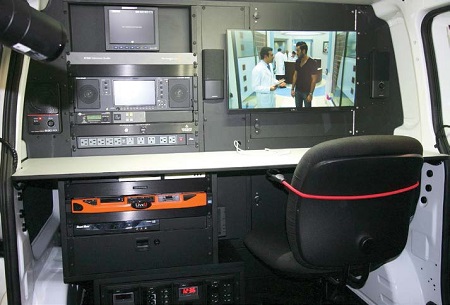The IP Effect on ENG Vehicles
OTTAWA— The evolution of ENG/SNG vehicle equipment has mirrored TV production as a whole. The latest ENG/SNG units use digital cameras, recording servers, routers, and (where needed) switchers; all linked to each other and the outside world via IP-based networking. It is just the most technically efficient—and cost-effective— way to produce ENG/SNG content today.
Due to IP’s ability to combine performance with cost savings, “all broadcast vehicles will eventually become IP. It’s only a matter of time,” predicted Steve Williamson, director of sales for Frontline Communications, a Clearwater, Fla.-based manufacturer of ENG vehicles. “Satellite has already evolved from DVB to lower-cost Ka-band—which is an IP data network— and Ku-IP,” Williamson noted. “Almost all vehicles also include IP-based bonded cellular encoders for terrestrial transmission, which can be used for Ka and Ku-IP satellite transmission.”

Telemundo affiliate WNJU-TV in the New York City DMA uses this Ka-band ENG van from AMT, built on the Ford Explorer platform. IP also offers cost savings for microwave users. For instance, the ENGenesis Bi-Directional LTE Microwave System and high-power Monsta Mesh products from Accelerated Media Technologies use both IP and LTE to connect stations and ENG/SNG trucks over broadcasters’ licensed 2 GHz broadcast microwave bands. This connectivity provides “both dedicated and proprietary network connectivity and private cellular networks to lower operating costs,” said Tom Jennings, president of AMT in Auburn, Mass. “This will eliminate the need for cable runs while allowing up to 10 news vehicles to transmit bidirectionally over the same channel—and make it easy for other IP-native resources to connect to other ENG/SNG IP-networked devices.”
DIGITAL DIVIDENDS
Even without IP factored in, digital technologies provide many beneficial changes to ENG/SNG vehicles.
The first big change is weight. Digital TV equipment is far lighter than its analog predecessors, and can thus be carried in smaller, less-heavy vans and SUVs. “This is why you are seeing new ENG/SNG vehicles being built on the Nissan NV HR and Ford Transit platforms, rather than the Ford E-350,” said John Payne, chief technology officer with Integrated Microwave Technologies in Mount Olive, N.J. “You no longer need that larger size of hauling capacity.”
The second major difference is power consumption. Compared to their electricity-devouring analog counterparts, today’s digital TV production equipment sips power. “You can have an entire ENG/SNG production system in a small SUV/Jeep or next-generation smaller van profile such as the ProMaster or Transit— including microwave and satellite transmitters— that gets up to 5–8 kilowatts of power from a custom [AMT] MVP Power Inverter/AGM Battery Pack connected directly to the engine,” Jennings said. “You don’t need a separate gas-powered generator anymore, and all the payload weight, expense and space such a device requires. The vehicles themselves have been upgraded from the factories to provide all of the HVAC you will ever need without 120V power.”
Digital’s third dividend is enhanced signal transmission capability. For terrestrial transmission, bonded cellular units that use commercial cellular networks provide ENG crews with low-cost, wide coverage twoway connectivity. So does the use of 2 GHz microwave transmission to support two-way file transfers between vehicles and stations. “We’ve seen tests where an ENG truck with its microwave mast down can still achieve distances up to 80 miles of reliable connections with data throughput speeds up to 10 Mbps,” Jennings said.
The professional video industry's #1 source for news, trends and product and tech information. Sign up below.

The combination of advances in digital technology and IP have enabled ENG/SNG truck manufacturers to reduce weight and fit more gear into smaller spaces. On the satellite side, the lower cost of Ka-band equipment and bandwidth compared to Ku-band—and Ka’s smaller equipment footprint—is making it the go-to choice for broadcasters.
“We have about 40 On Call Communications Ka-band satellite systems, which are compact enough to put on small SUVs,” said Jason Effinger, senior vice president of media and technology for station group Gray Television in Atlanta. “Add this to approximately 120 bonded cellular portables that we use for ENG—primarily made by TVU Networks—and you can see that Gray Television is committed to the benefits of digital ENG/SNG.”
The last big benefit is simplicity: “Today’s digital ENG/SNG trucks are so easy to set up and operate, that one vehicle can be run by a single reporter,” said Payne. “No longer do you have to pay for a dedicated truck operator and perhaps a producer as well. One person can do it all.”
All these digital advantages are of particular interest to the EW Scripps Co. and its 33 TV stations. “We are looking very seriously at IP-based newsgathering, which we think is a very exciting area to explore,” said Ray Thurber, vice president of engineering for television for the Cincinnati-based company. “It offers us the ability to do ENG/SNG better, simpler, and cheaper than the old ways of covering news in the field.”
Looking ahead, the continued evolution of ENG/ENG vehicles will “mirror the cellphone industry, if you remember the cellphones from the ’80s,” Williamson said. “Broadcast vehicles will continue to get smaller and smarter and have more features and capabilities and costs will continue to come down, both capital costs and operating costs.”
How drastic a change will this be? “What we envision looks nothing like what you see today,” Williamson replied.
James Careless is an award-winning journalist who has written for TV Technology since the 1990s. He has covered HDTV from the days of the six competing HDTV formats that led to the 1993 Grand Alliance, and onwards through ATSC 3.0 and OTT. He also writes for Radio World, along with other publications in aerospace, defense, public safety, streaming media, plus the amusement park industry for something different.

